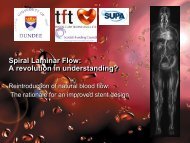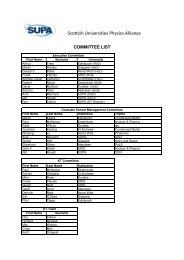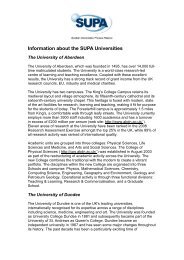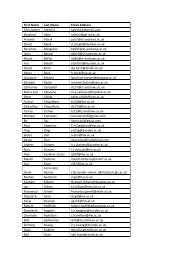- Page 1 and 2:
Scottish Universities Physics Allia
- Page 3 and 4:
Abdulgalil, A Ali Abdulgalil Resear
- Page 5 and 6:
Ackland, GJ Graeme Ackland Academic
- Page 7 and 8:
Allen, RJ Rosalind Allen Academic T
- Page 9 and 10:
Current Research My main research a
- Page 11 and 12:
Arnold, AS Aidan Arnold Academic Un
- Page 13 and 14:
Analog and digital simulations of M
- Page 15 and 16:
Barnes, F Francis Barnes Researcher
- Page 17 and 18:
Two-axis temperature-insensitive ac
- Page 19 and 20:
The evaporative cooling system for
- Page 21 and 22:
Beck, R Rainer Beck Research Studen
- Page 23 and 24:
Bennet, ED Euan Bennet Research Stu
- Page 25 and 26:
The relation between star formation
- Page 27 and 28:
3D PiC code simulations for a labor
- Page 29 and 30:
Bishop, M Maria Bishop Research Stu
- Page 31 and 32: Search for gravitational waves from
- Page 33 and 34: Er : Yb-doped oxyfluoride silicate
- Page 35 and 36: Measurement of the production cross
- Page 37 and 38: MBE Growth and Characterization of
- Page 39 and 40: Breitmoser, E Elena Breitmoser Rese
- Page 41 and 42: Brown, JC John Brown Academic Unive
- Page 43 and 44: Buczynski, R Ryszard Buczynski Rese
- Page 45 and 46: Thermocapillary manipulation of dro
- Page 47 and 48: Power-Scaling of a 1060nm Semicondu
- Page 49 and 50: Measurement of inclusive jet cross
- Page 51 and 52: Search for new heavy particles deca
- Page 53 and 54: Current Research My research has be
- Page 55 and 56: Characterisation of an InAs Quantum
- Page 57 and 58: The first magnetic maps of a pre-ma
- Page 59 and 60: Imaging the dense stellar cluster R
- Page 61 and 62: Optical micromanipulation using sup
- Page 63 and 64: Lattice Boltzmann simulations of sp
- Page 65 and 66: Microstructure of precipitates and
- Page 67 and 68: Cirasuolo, M Michele Cirasuolo Rese
- Page 69 and 70: Clark, C Christopher Caspar Clark R
- Page 71 and 72: Study of resonances in exclusive B
- Page 73 and 74: Measurement of D-0-(D)over-bar(0) m
- Page 75 and 76: Observation and Polarization Measur
- Page 77 and 78: Clegg, PS Paul Clegg Academic The U
- Page 79 and 80: The Higgs discovery potential of AT
- Page 81: Cowie, E Euan Cowie Research Studen
- Page 85 and 86: A joint search for gravitational wa
- Page 87 and 88: High Power Masers based on 2D perio
- Page 89 and 90: Implications for the origin of GRB
- Page 91 and 92: Power law carrier dynamics in semic
- Page 93 and 94: Cross section measurements of high-
- Page 95 and 96: Limits on the production of narrow
- Page 97 and 98: Search for pair production of scala
- Page 99 and 100: Dawson, A Angela Dawson Researcher
- Page 101 and 102: GaInNAs(Sb) surface normal devices
- Page 103 and 104: Pulsed laser micromachining of yttr
- Page 105 and 106: Generation of multiple Bessel beams
- Page 107 and 108: Tunneling mediated by 2D+1 conical
- Page 109 and 110: Discovery of a Jupiter/Saturn analo
- Page 111 and 112: Three- and four-jet final states in
- Page 113 and 114: Clarifying the nature of the bright
- Page 115 and 116: Current Research The power of the l
- Page 117 and 118: Edwards, T Thomas Edwards Research
- Page 119 and 120: Enoch, B Becky Enoch Researcher Uni
- Page 121 and 122: Evans, CJ Chris Evans Academic The
- Page 123 and 124: Science Requirements for EAGLE for
- Page 125 and 126: Two-axis temperature-insensitive ac
- Page 127 and 128: Interfacial spin effects on H-ex in
- Page 129 and 130: Firth, L Leon Firth Academic Univer
- Page 131 and 132: Design of a high power W-band maser
- Page 133 and 134:
Forgan, D Duncan Forgan Research St
- Page 135 and 136:
Fraser, HJ Helen Fraser Academic Un
- Page 137 and 138:
Galster, W Wilf Galster Researcher
- Page 139 and 140:
Three-core tellurite fiber with mul
- Page 141 and 142:
Performance of the LHCb vertex dete
- Page 143 and 144:
Giet, S Stephanie Giet Research Stu
- Page 145 and 146:
Active focus locking in an opticall
- Page 147 and 148:
Patterning and integration of polyf
- Page 149 and 150:
Measurement of the branching fracti
- Page 151 and 152:
Measurement of the spin of the Xi(1
- Page 153 and 154:
Measurement of the Branching Fracti
- Page 155 and 156:
Gregoire, T Thomas Gregoire Researc
- Page 157 and 158:
Smooth inductively coupled ring tra
- Page 159 and 160:
Etching and micro-optics fabricatio
- Page 161 and 162:
Hadfield, RH Robert Hadfield Academ
- Page 163 and 164:
Development of edge pumped Yb : YAG
- Page 165 and 166:
Hammond G Giles Hammond Academic Un
- Page 167 and 168:
Current Research Duncan Hand is Pro
- Page 169 and 170:
Confocal laser scanning microscopy
- Page 171 and 172:
Electroexcitation of the Roper reso
- Page 173 and 174:
Haughian, K Karen Haughian Research
- Page 175 and 176:
Laboratory Reproduction of Auroral
- Page 177 and 178:
WASP-4b: A 12th magnitude transitin
- Page 179 and 180:
Hellwig, T Thomas Hellwig Research
- Page 181 and 182:
Search for Gravitational-Wave Burst
- Page 183 and 184:
Hill, D David Hill Research Student
- Page 185 and 186:
Hoek, M Matthias Hoek Researcher Un
- Page 187 and 188:
Holms, K Kenny Holms Research Stude
- Page 189 and 190:
ARTEMS (Automated Robotic Terrestri
- Page 191 and 192:
First joint search for gravitationa
- Page 193 and 194:
Hughes, D David Hughes Research Stu
- Page 195 and 196:
Astrophysically triggered searches
- Page 197 and 198:
Polarized structure function sigma(
- Page 199 and 200:
ULTRASPEC - An Electron Multiplicat
- Page 201 and 202:
Large-scale magnetic topologies of
- Page 203 and 204:
Current Research Research spans two
- Page 205 and 206:
Pulsed laser micromachining of yttr
- Page 207 and 208:
High-temperature excess current and
- Page 209 and 210:
Kar, AK Ajoy Kar Academic Heriot-Wa
- Page 211 and 212:
Kaziannis, S Spyros Kaziannis Resea
- Page 213 and 214:
Synthetic diamond for intracavity t
- Page 215 and 216:
Current Research Simulation of latt
- Page 217 and 218:
Arrest of fluid demixing by nanopar
- Page 219 and 220:
Free-electron maser based on a cavi
- Page 221 and 222:
Influence of residual disorder on t
- Page 223 and 224:
Dispersion control and slow light i
- Page 225 and 226:
Current Research Photonic crystals
- Page 227 and 228:
Diode-pumped passively mode-locked
- Page 229 and 230:
Delayed rapid passage and transient
- Page 231 and 232:
High throughput diffractive multi-b
- Page 233 and 234:
Etching and micro-optics fabricatio
- Page 235 and 236:
Transmutation of singularities in o
- Page 237 and 238:
Li, M Martin Li Research Student Th
- Page 239 and 240:
Livingston, K Kenneth Livingston Re
- Page 241 and 242:
All-sky search for periodic gravita
- Page 243 and 244:
Lorenz, N Norbert Lorenz Research S
- Page 245 and 246:
Ma, N Nan Ma Research Student Unive
- Page 247 and 248:
Current Research Professor Andy Mac
- Page 249 and 250:
Origins of ferromagnetism in transi
- Page 251 and 252:
Radial deformation measurement of a
- Page 253 and 254:
Current Research Robert's research
- Page 255 and 256:
Data preservation and the virtual o
- Page 257 and 258:
Martin, I Ian Martin Research Stude
- Page 259 and 260:
Optical energies of AlInN epilayers
- Page 261 and 262:
First measurement of W boson produc
- Page 263 and 264:
Search for new heavy particles deca
- Page 265 and 266:
Weak-lensing ellipticities in a str
- Page 267 and 268:
Physical results from 2+1 flavor do
- Page 269 and 270:
UV Direct-Writing of Metals on Poly
- Page 271 and 272:
McDonald, P Peter McDonald Research
- Page 273 and 274:
McKee, D David McKee Researcher Uni
- Page 275 and 276:
The LHCb Detector at the LHC Alves,
- Page 277 and 278:
Current Research Much of Brian McNe
- Page 279 and 280:
Current Research My research intere
- Page 281 and 282:
Weak measurements with entangled pr
- Page 283 and 284:
Leptogenesis in the exceptional sup
- Page 285 and 286:
Moore, S Stephen Moore Research Stu
- Page 287 and 288:
Mouat, A Adrian Mouat Researcher Th
- Page 289 and 290:
Determination of the form factors f
- Page 291 and 292:
Murdoch, D Derek Murdoch Research S
- Page 293 and 294:
Search of S3 LIGO data for gravitat
- Page 295 and 296:
Search for Gravitational-Wave Burst
- Page 297 and 298:
Massive dark matter haloes around b
- Page 299 and 300:
The effect of growth temperature on
- Page 301 and 302:
Physics-based mathematical models f
- Page 303 and 304:
O'Shea, V Val O'Shea Academic Unive
- Page 305 and 306:
Hydrodynamic interactions in two di
- Page 307 and 308:
Panter, B Ben Panter Researcher The
- Page 309 and 310:
Performance of the LHCb vertex dete
- Page 311 and 312:
Electroproduction of phi(1020) meso
- Page 313 and 314:
The limb-darkened Arcturus: imaging
- Page 315 and 316:
First double-sided 3-D detectors fa
- Page 317 and 318:
Wave propagation and tunneling thro
- Page 319 and 320:
Alternative calculation of the Casi
- Page 321 and 322:
Density and well-width dependence o
- Page 323 and 324:
Is there potential complementarity
- Page 325 and 326:
Search for decays of B-0 mesons int
- Page 327 and 328:
Observation of B+->eta rho(+) and s
- Page 329 and 330:
Measurement of ratios of branching
- Page 331 and 332:
Beating the spin-down limit on grav
- Page 333 and 334:
Slip and Flow of Hard-Sphere Colloi
- Page 335 and 336:
ZnSe Hybrid Microcavities Fabricate
- Page 337 and 338:
First measurement of target and dou
- Page 339 and 340:
Radwell, N Neal Radwell Research St
- Page 341 and 342:
Shaping ultrafast laser inscribed o
- Page 343 and 344:
Designer femtosecond pulse shaping
- Page 345 and 346:
Reid, S Stuart Reid Researcher Univ
- Page 347 and 348:
Current Research Current research i
- Page 349 and 350:
Free-electron maser based on a cavi
- Page 351 and 352:
Search for gravitational waves asso
- Page 353 and 354:
Infrared dust bubbles: Probing the
- Page 355 and 356:
Search for chargino-neutralino prod
- Page 357 and 358:
Measurement of the inclusive jet cr
- Page 359 and 360:
Ronald, K Kevin Ronald Academic Uni
- Page 361 and 362:
Roqan, IS Iman Roqan Research Stude
- Page 363 and 364:
Measurement of azimuthal asymmetrie
- Page 365 and 366:
The effects of heating on mechanica
- Page 367 and 368:
Rozbicki, E Emil Rozbicki Research
- Page 369 and 370:
An organic semiconductor laser on s
- Page 371 and 372:
Iridium metal complexes as an unamb
- Page 373 and 374:
Savitski, V Vasili Savitski Researc
- Page 375 and 376:
Gelation of particles with short-ra
- Page 377 and 378:
Scovell, P Paul Scovell Research St
- Page 379 and 380:
Nanoscale optical microscopy in the
- Page 381 and 382:
Artificial collimation of fast-elec
- Page 383 and 384:
First detection of galaxy-galaxy-ga
- Page 385 and 386:
Smith, G Graham Smith Academic Univ
- Page 387 and 388:
Measurement of ep -> ep pi(0) beam
- Page 389 and 390:
Flux measurement at a Neutrino Fact
- Page 391 and 392:
Axis-encircling electron beam gener
- Page 393 and 394:
Current Research In general, my res
- Page 395 and 396:
Strain, KA Ken Strain Academic Univ
- Page 397 and 398:
Modelling and Evaluation of Spectra
- Page 399 and 400:
Direct Laser-Writing of Polymer Str
- Page 401 and 402:
Taghizadeh, MR Mo Taghizadeh Academ
- Page 403 and 404:
Tamai, A Anna Tamai Researcher Univ
- Page 405 and 406:
A cautionary note on cosmological m
- Page 407 and 408:
Thomson, CL Caroline Thomson Resear
- Page 409 and 410:
Current Research Robert Thomson is
- Page 411 and 412:
Implications for the origin of GRB
- Page 413 and 414:
Search for gravitational waves from
- Page 415 and 416:
Tresca, O Olivier Tresca Research S
- Page 417 and 418:
Two-photon absorption and lasing in
- Page 419 and 420:
Ubiali, M Maria Ubiali Research Stu
- Page 421 and 422:
Vangeleyn, M Matthieu Vangeleyn Res
- Page 423 and 424:
Comparison of simulated quenching a
- Page 425 and 426:
Innovative Optical and Electronic I
- Page 427 and 428:
Resonant transmission spectroscopy
- Page 429 and 430:
Ward, C Charles Ward Research Stude
- Page 431 and 432:
New light from hybrid inorganic-org
- Page 433 and 434:
Observation of B-0 -> K-*0(K)over-b
- Page 435 and 436:
Observation of B+-> b(1)(+)K(0) and
- Page 437 and 438:
Search for the highly suppressed de
- Page 439 and 440:
The DIRC detectors of the (P)over-b
- Page 441 and 442:
Ultracompact and low-power optical
- Page 443 and 444:
Broadband gyro-TWA with thermionic
- Page 445 and 446:
Carbon nanotube arrays for optical
- Page 447 and 448:
Current Research Gravitational wave
- Page 449 and 450:
EMISSION FROM VERY SMALL GRAINS AND
- Page 451 and 452:
Spectroscopy of proton-rich nuclei
- Page 453 and 454:
Milky way potentials in cold dark m
- Page 455 and 456:
Observation of B-0 -> K-*0(K)over-b
- Page 457 and 458:
Yang, Y Ying Yang Research Student
- Page 459 and 460:
Broadband gyro-TWA with thermionic
- Page 461 and 462:
Efficient flip-chip InGaN micro-pix
- Page 463 and 464:
An analytic model for non-spherical







